#Tanzu Kubernetes with vSphere
Explore tagged Tumblr posts
Text
VMware vSphere 8.0 Update 2 New Features and Download
VMware vSphere 8.0 Update 2 New Features and Download @vexpert #vmwarecommunities #vSphere8Update2Features #vGPUDefragmentationInDRS #QualityOfServiceForGPUWorkloads #vSphereVMHardwareVersion21 #NVMEDiskSupportInVSphere #SupervisorClusterDeployments
VMware consistently showcases its commitment to innovation when it comes to staying at the forefront of technology. In a recent technical overview, we were guided by Fai La Molari, Senior Technical Marketing Architect at VMware, on the latest advancements and enhancements in vSphere Plus for cloud-connected services and vSphere 8 update 2. Here’s a glimpse into VMware vSphere 8.0 Update 2 new…
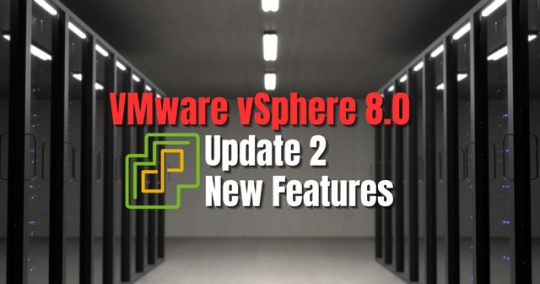
View On WordPress
#NVMe disk support in vSphere#Quality of Service for GPU workloads#Supervisor Cluster deployments#Tanzu Kubernetes with vSphere#vGPU defragmentation in DRS#VM management enhancements#vSphere 8 update 2 features#vSphere and containerized workload support#vSphere DevOps integrations#vSphere VM hardware version 21
0 notes
Text
Invigorate Your IT Potential with VMware Training from Ascendient Learning
VMware is at the forefront of virtualization solutions, powering software-defined data centers, hybrid clouds, and secure infrastructure management for enterprises worldwide. With over 500,000 customers globally, including all Fortune 500 companies, VMware expertise significantly enhances your value as an IT professional.
Ascendient Learning, named VMware's North American Learning Partner of the Year in 2023, offers comprehensive, industry-leading VMware training to help you stay competitive.
Comprehensive VMware Training at Ascendient Learning
Ascendient Learning offers an extensive portfolio of VMware-certified courses covering the most critical VMware technologies. Training is available for:
vSphere: The foundational technology for software-defined data centers. Courses like "VMware vSphere: Install, Configure, Manage [V8]" and "Operate, Scale and Secure [V8]" provide critical virtualization and management skills.
NSX: VMware NSX courses teach vital network virtualization and cybersecurity skills. Popular courses include "VMware NSX: Install, Configure, Manage [V4.0]" and "NSX: Troubleshooting and Operations."
vSAN: This training equips professionals to efficiently deploy and manage software-defined storage solutions. Courses like "VMware vSAN: Install, Configure, Manage [V8]" and "VMware vSAN: Troubleshooting [V8]" ensure you’re skilled in the latest storage innovations.
vRealize Suite: Ascendient offers training on advanced cloud automation and orchestration tools, crucial for streamlining IT processes and infrastructure management.
Tanzu and Kubernetes: Ascendient’s Tanzu courses, including "VMware vSphere with Tanzu: Deploy, Configure, Manage," empower IT teams to build and manage modern cloud-native applications efficiently.
VMware Aria Suite: Training in VMware Aria helps professionals achieve advanced operational insights and efficient cloud automation management, including "VMware Aria Automation: Orchestration and Extensibility."
Flexible Training Formats Designed for Real-Life Schedules
Ascendient Learning recognizes the need for training that adapts to your busy professional life. Therefore, VMware training is offered in various convenient formats:
Instructor-Led Virtual Sessions: Participate interactively with expert instructors in real-time virtual environments.
Guaranteed-to-Run Classes: Ascendient provides one of North America's largest Guaranteed-to-Run (GTR) VMware course schedules, offering reliability and predictable scheduling.
Self-Paced Online Learning: Ideal for professionals seeking complete flexibility, these courses allow learners to progress at their own pace without compromising content quality or depth.
In-Person Classroom Training: Engage directly with instructors and peers through traditional classroom-based training, fostering collaboration and hands-on practice.
Real Benefits: Proven ROI for Professionals and Organizations
Investing in VMware training with Ascendient Learning delivers tangible benefits. According to recent research, organizations with VMware-trained teams experience increased productivity, improved employee satisfaction, and reduced employee turnover. Ascendient learners have successfully leveraged VMware skills to secure promotions, negotiate salary increases, and transition into high-demand roles like Solutions Architects, Systems Engineers, Cloud Architects, and Network Specialists.
For instance, companies implementing VMware vSAN and NSX through certified professionals have reported drastic improvements in data center efficiency, significantly lowering costs while boosting infrastructure performance and security.
Your Path to VMware Certification Starts Here
VMware-certified professionals are consistently in high demand. Achieving VMware certification through Ascendient Learning positions you strategically within the IT landscape, opening doors to better opportunities, higher salaries, and greater professional satisfaction. The industry increasingly values and rewards VMware expertise, making this training a strategic investment for both individual career growth and organizational success.
Take the next step today. Join the thousands who have accelerated their careers and transformed their organizations through VMware training at Ascendient Learning.
Enroll with Ascendient Learning and master VMware technology to shape your future in IT leadership.
For more information visit: https://www.ascendientlearning.com/it-training/vmware
0 notes
Text
Top 10 Cloud Services Providers in 2024
As we move into 2024, cloud computing continues to play a critical role in digital transformation for businesses worldwide. From startups to large enterprises, cloud services provide scalable infrastructure, cost-effective solutions, and the ability to innovate rapidly. But with so many providers in the market, it can be challenging to choose the right one.
In this article, we will explore the Top 10 Cloud Services Providers in 2024, highlighting their strengths, features, and why they stand out. Whether you're looking for public, private, or hybrid cloud solutions, these companies offer diverse options to meet your needs.

1. Amazon Web Services (AWS)
AWS remains the dominant force in the cloud services market in 2024, offering a wide array of services, including computing power, storage, and AI tools. With its global reach and continuous innovation, AWS is a preferred choice for both startups and large corporations.
Key Features:
Elastic Compute Cloud (EC2)
Simple Storage Service (S3)
Machine Learning and AI services
Serverless computing (AWS Lambda)
2. Microsoft Azure
Microsoft Azure has seen massive growth and remains a top cloud provider in 2024. Its integration with Microsoft products, especially Office 365, makes Azure highly attractive for businesses. Azure's hybrid cloud solutions are also favored by enterprises seeking flexibility.
Key Features:
Virtual Machines (VMs)
Azure SQL Database
DevOps Tools
AI and Machine Learning capabilities
3. Google Cloud Platform (GCP)
Google Cloud Platform (GCP) stands out for its big data, machine learning, and AI capabilities. GCP is the go-to provider for organizations looking to leverage AI for competitive advantage. With continuous investments in its cloud infrastructure, GCP offers high performance, reliability, and innovation.
Key Features:
BigQuery for data analytics
Kubernetes Engine for container management
AI and machine learning tools (TensorFlow)
Comprehensive security features
4. IBM Cloud
IBM Cloud focuses on hybrid and multi-cloud environments, making it a preferred provider for enterprises with complex IT needs. IBM Cloud's integration with its AI, Watson, and blockchain technologies sets it apart, especially for industries like healthcare, finance, and manufacturing.
Key Features:
Hybrid cloud solutions
AI and Watson services
Blockchain as a Service (BaaS)
Secure and scalable infrastructure
5. Oracle Cloud Infrastructure (OCI)
Oracle Cloud Infrastructure (OCI) is designed for high-performance computing workloads and large-scale data operations. Oracle Cloud stands out for its database management solutions and its ability to handle critical workloads for enterprises.
Key Features:
Autonomous Database
Oracle Cloud Applications
AI-driven analytics
Hybrid and multi-cloud capabilities
6. Alibaba Cloud
Alibaba Cloud, the largest cloud provider in China, is expanding its footprint globally. With its robust e-commerce and big data capabilities, Alibaba Cloud is ideal for businesses looking to tap into the Asian market.
Key Features:
Global Content Delivery Network (CDN)
Advanced AI and data analytics
Elastic Compute Service (ECS)
Strong presence in the Asia-Pacific region
7. Salesforce Cloud
Salesforce Cloud is known for its CRM solutions but has expanded its offerings to include cloud infrastructure. Salesforce's customer-centric solutions are ideal for businesses looking to enhance customer engagement through cloud-based tools.
Key Features:
Salesforce CRM
Marketing Cloud and Commerce Cloud
AI-powered Einstein analytics
Integration with third-party applications
8. VMware Cloud
VMware Cloud is a leader in virtualization and offers robust multi-cloud and hybrid cloud solutions. With its partnerships with AWS, Microsoft, and Google, VMware Cloud enables businesses to run, manage, and secure applications across cloud environments.
Key Features:
vSphere for virtualization
VMware Tanzu for Kubernetes management
CloudHealth for cost management
Extensive hybrid cloud capabilities
9. SAP Cloud Platform
SAP Cloud Platform provides specialized solutions for enterprises, particularly in the areas of ERP and business management. SAP’s cloud offerings are designed to help businesses with digital transformation by integrating cloud services into their existing SAP environments.
Key Features:
SAP S/4HANA for enterprise resource planning
Business intelligence tools
AI and machine learning for predictive analytics
Enterprise-level security and compliance
10. DigitalOcean
DigitalOcean focuses on simplicity and affordability, making it a great choice for startups, developers, and small businesses. DigitalOcean is best known for its developer-friendly cloud infrastructure and its ease of use for hosting and scaling applications.
Key Features:
Droplets (cloud servers)
Kubernetes for container orchestration
Managed databases
Affordable and easy-to-use interface
FAQs on Cloud Services Providers in 2024
Q1: What are cloud services providers?
Cloud services providers are companies that offer computing services over the internet. These services can include storage, servers, databases, networking, software, analytics, and intelligence.
Q2: How do I choose the right cloud services provider?
Choosing the right provider depends on your business needs, such as scalability, security, pricing, support, and specific tools or services required. It's important to compare providers based on your goals.
Q3: Is AWS better than Google Cloud or Microsoft Azure?
Each provider has its strengths. AWS is known for its extensive services and global reach, Azure integrates well with Microsoft products, and Google Cloud excels in AI and data analytics. The best choice depends on your specific use case.
Q4: Can small businesses benefit from cloud services?
Yes, cloud services offer scalable and cost-effective solutions for small businesses. Providers like DigitalOcean and Google Cloud offer affordable plans tailored to startups and small businesses.
Q5: What are hybrid cloud solutions?
Hybrid cloud solutions combine private and public clouds, allowing businesses to manage their data and applications across multiple environments. This offers flexibility and better control over resources.
What is Cloud Computing?
Cloud computing refers to the delivery of computing services over the internet (the cloud), enabling users to access and use data, software, and hardware remotely without having to manage physical infrastructure. Cloud computing offers scalability, flexibility, and cost efficiency, making it a key driver of modern business transformation.
Conclusion
Choosing the right cloud services provider is critical for ensuring the success of your business in 2024. Whether you're looking for AI-driven analytics, secure hybrid solutions, or cost-effective infrastructure, these top 10 providers offer reliable and innovative solutions to meet your needs. As types of cloud computing evolves, staying up-to-date with the latest offerings from these providers can give your business a competitive edge.
Contact us: [email protected]
Social Accounts:
0 notes
Text
Kubernetes is hot and everyone loses their minds
We all witnessed Pat Gelsinger invite Kubernetes to vSphere and all of a sudden every IT manager on the planet needs to have a Kubernetes strategy. There are many facets to understanding and embracing Kubernetes as the platform of the future coming from a traditional IT mindset. Are we ready?
Forgetting IaaS
With the recent announcement from SUSE to abandon OpenStack in favor of their container offerings, where are we going to run these containers? Kubernetes does not replace the need to effectively provision infrastructure resources. We need abstractions to provision servers, networks and storage to run the Kubernetes clusters on. The public cloud vendors obviously understands this but are we simply giving the hybrid cloud market to VMware? Is vSphere the only on-prem IaaS that will matter down the line? Two of the biggest cloud vendors rely on VMware for their hybrid offerings. Google Anthos and Amazon Outpost.
Rise Above
In the new brave world IT staff needs to start thinking drastically different on how they manage and consume resources. New tools need to be honed to make developers productive (and first and foremost, happy) and not have them run off with shadow IT. There’s an apparent risk that we’ll leapfrog from one paradigm to another without understanding the steps necessary in between to embrace Kubernetes.

Since my first KubeCon in 2016 I immediately understood that Kubernetes is going to become the defacto "operating system” for multi-node computing. There’s nothing you can’t do on Kubernetes you did yesterday with headless applications. It gives you way too much for free. Why would you be stuck in imperative patterns with toil overload when the declarative paradigm is readily available for your developers and operations team?
Start now Mr. IT Manager
Do not sit around and wait for Tanzu and Project Pacific to land in your lap. There are plenty of Kubernetes distributions with native integration with vSphere that allow your teams to exercise the patterns required to be successful at deploying and running K8s in a production setting.
Here’s a non-exhaustive list with direct links to the vSphere integration of each:
Google Anthos
Rancher
Red Hat OpenShift
Juju
Kops
The Go library for the VMware vSphere API has a good list of consumers too. So start today!
2 notes
·
View notes
Text
Wild 9 universal hub key

Wild 9 universal hub key software#
Going forward new log4j vulnerabilities will continue to be evaluated to determine severity and applicability to VMware products, but will not be referenced in this advisory. VMware has investigated and has found no evidence that these vulnerabilities are exploitable in VMware products.
Wild 9 universal hub key software#
7: A pair of new vulnerabilities identified by CVE-2021-45105 and CVE-2021-44832 have been disclosed by the Apache Software Foundation that impact log4j releases prior to 2.17.1 in non-default configurations.7: The Apache Software Foundation updated the severity of CVE-2021-45046 to 9.0, in response we have aligned our advisory.In response, VMware has aligned with the new guidance and will be updating associated documentation with workarounds and fixes to address both vulnerabilities completely. In addition, a new vulnerability identified by CVE-2021-45046 was published. 4: The Apache Software Foundation notified the community that their initial guidance for CVE-2021-44228 workarounds were not sufficient in removing all possible attack vectors.3: Unaffected VMware products can be referred to on the Knowledge Base article:.1: A supplemental blog post & frequently asked questions list was created for additional clarification.0: Exploitation attempts in the wild of CVE-2021-44228 have been confirmed by VMware.VMware vRealize Operations Management Pack.VMware vRealize Operations Tenant App for VMware Cloud Director.VMware Harbor Container Registry for TKGI.VMware Cloud Provider Lifecycle Manager.VMware Cloud Director Object Storage Extension.Single Sign-On for VMware Tanzu Application Service.Healthwatch for Tanzu Application Service.VMware Tanzu Observability by Wavefront Nozzle.VMware Tanzu Kubernetes Grid Integrated Edition.VMware Tanzu Application Service for VMs.VMware Tanzu Greenplum Platform Extension Framework.VMware Carbon Black Cloud Workload Appliance.VMware Site Recovery Manager, vSphere Replication.VMware vRealize Operations Cloud (Cloud Proxy).

0 notes
Text
Subnet mask table 4 bits

#SUBNET MASK TABLE 4 BITS HOW TO#
#SUBNET MASK TABLE 4 BITS UPGRADE#
#SUBNET MASK TABLE 4 BITS SOFTWARE#
#SUBNET MASK TABLE 4 BITS PLUS#
IP addresses are either configured by a DHCP server or manually configured (static IP addresses). Get familar with related technical terms.Support Contact support to resolve issues.Professional Services Engage with professional services for migration and customization.Knowledge Base Get the best documentation on our product.LBTV Hits all major topics of modern load balancing.Virtual Summit Attend a quarterly summit to learn more.Webinars Join our subject matter experts to explore a use case.Content Library Find everything related to multi-cloud load balancing.How-To Videos Watch 3-5 min videos and learn new skills.
#SUBNET MASK TABLE 4 BITS HOW TO#
Operations Videos Learn how to deploy our prooduct.Workshops Attend free workshops to get hands-on.Start Here Get the catalog of all eduational offerings.Container Ingress Connect and secure container applications.
#SUBNET MASK TABLE 4 BITS SOFTWARE#
Software Load Balancer Modernize hardware load balancers.
Intelligent WAF Protect web applications with WAF.
Overview Bring simplicity and flexibilty to consume cloud services.
VMware Tanzu Bridge lab-to-production gap with Kubernetes Ingress Services.
Kubernetes Deliver enteprise-grade ingress services for any container platform.
OpenStack Build private cloud with advanced load balancing on OpenStack.
Google Cloud Platform Future-proof application delivery for Google Cloud.
Amazon Web Services Make multi-cloud load balancing easy for AWS.
Microsoft Azure Deliver enteprise-grade load balancing on Azure.
VMware vSphere Modernize data center and extend VMware load balancing anywhere.
VMware Horizon Enable remote working with the best integrated VDI solution.
VMware NSX Connect and secure your workloads with native NSX integration.
Web Application Firewall Secure web apps with scalable application security.
#SUBNET MASK TABLE 4 BITS UPGRADE#
Upgrade from F5 Replace legacy load balancers with modern load balancing.
Platform Architecture Take a new approach to application services.
Platform Overview Deep dive into software-defined architecture.
What We Do Understand multi-cloud load balancing.
It not only calculates the required fields but also pops out a window that draws the bit pattern and explains the results. With Windows 2000 and beyond Subnetting you do not have to do that anymore.īTW, if you need to calculate Subnet Masks and Network IDs and you can’t do it yourself (Duh, “Paper MCSE” or not?) you should try this fantastic Subnet Calculator right here: the result would have been 240 instead of 224. If you wanted 8 subnets, you had to calculate like you wanted 10, i.e.
#SUBNET MASK TABLE 4 BITS PLUS#
For example, if you wanted 2 subnets, you had to figure the number you wanted plus 2 – calculate like you wanted 4, i.e. Note: In Windows NT 4.0 you had to subtract 2 from the total number of available subnets. Only in Class C networks does the N value remain the same. In a Class B network instead of saying 5 (for example again, duh!) you must say 5+8. Therefore in a Class A network instead of saying 7 (for example) you must say 7+8+8. N=Number of Non-masked bits – Remember that in Class A and B networks you have other octets besides the one you’re subnetting. The table deals with Subnetting of only one octet. Use this table to help you calculate Subnet Masks, available hosts per subnet or number of subnets per class.

0 notes
Text
Introducing Service Installer for VMware Tanzu
Introducing Service Installer for VMware Tanzu
Service Installer for VMware Tanzu is a one-click automation solution that enables VMware field engineers to easily and rapidly install, configure, and operate VMware Tanzu Kubernetes Grid on VMware vSphere, VMware Cloud on AWS, VCF, AWS, Azure, and VMware Tanzu Kubernetes Grid Service on VMware vSphere 7.0U2 & above. In this blog post, we will see how to configure the service installer for…
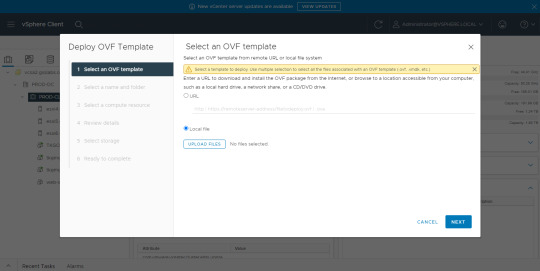
View On WordPress
0 notes
Text
Error en vSphere with Tanzu: Harbor registry on cluster domian is unhealtly 😱
Hoy les traigo una publicación sobre un error en vSphere with Tanzu con Harbor #vmware #tanzu #harbor #kubernetes
¿Cómo están estimados? ¡Espero que bien! Hoy les traigo una publicación sobre un error que nos apareció en VMware vSphere with Tanzu a la hora de desplegar el servicio de Harbor Registry embebido. Vayamos por parte. Antes que nada, quisiera realizar una muy breve explicación de que es Harbor y a que me refiero con “embebido”: ¿Qué es Harbor Registry? Harbor es un repositorio de código abierto…

View On WordPress
0 notes
Text
5V0-23.20 Practice Test Questions - VMware vSphere with Tanzu Specialist
5V0-23.20 VMware vSphere with Tanzu Specialist exam is a new exam associated with VMware Certified Specialist - vSphere with Tanzu 2022 Certification. PassQuestion new released the latest 5V0-23.20 Practice Test Questions which will help you to get high score in your VMware vSphere with Tanzu Specialist exam in the first attempt! 5V0-23.20 Practice Test Questions will also give you a clear idea of how you can take a real VMware 5V0-23.20 exam. It will help you assess your current preparation level so you can improve your preparation for the final VMware 5V0-23.20 exam. Make sure that you are using up to date 5V0-23.20 Practice Test Questions so you can easily clear the VMware vSphere with Tanzu Specialist exam on the first shot.
Exam 5V0-23.20 : VMware vSphere with Tanzu Specialist
The VMware vSphere with Tanzu Specialist exam (5V0-23.20) which leads to VMware Certified Specialist - vSphere with Tanzu 2022 badge is a 62-item exam, with a passing score of 300 using a scaled method. Exam time is 125 minutes. VMware vSphere with Tanzu Specialist exam validates a candidate's knowledge about how vSphere with Tanzu can be used to orchestrate the delivery of Kubernetes clusters and containerized applications in a vSphere environment as well as their knowledge of deploying and managing VMware vSphere® with Tanzu.
Exam Information
Number of Questions: 62 Duration: 125 Minutes Passing Score: 300 Format: Single and Multiple Choice, Proctored Language: English Pricing: $250 USD Associated Certification: VMware Certified Specialist - vSphere with Tanzu 2022
Exam Sections
Section 1 Introduction - No testable objectives for this section Section 2 Introduction to Containers and Kubernetes - No testable objectives for this section Section 3 Introduction to vSphere with Tanzu Section 4 vSphere with Tanzu Core Services Section 5 Tanzu Kubernetes Grid Service Section 6 Monitoring and Troubleshooting in vSphere with Tanzu - No testable objectives for this section Section 7 vSphere with Tanzu Life Cycle
View Online VMware vSphere with Tanzu Specialist 5V0-23.20 Free Questions
What is the minimum number of portgroups needed, in addition to the management portgroup. to provide connectivity for external services on a Supervisor Cluster? A.1 B.4 C.3 D.2 Answer : A
Which is a valid version change for a Tanzu Kubernetes cluster running Kubernetes version 1.16.7? A.Upgrade one major version (e.g.. 2.0.1) B.Upgrade two minor versions (e.g., 1.18.0) C.Downgrade one patch version (e.g.. 1.16.5) D.Upgrade one minor version (e.g.. 1.17.0) Answer : D
Which command displays the storage limits that have been set together with the amount of resources consumed? A.kubect1 get resourcequotas B.kubect1 config get-resourcequotas limits C.kubect1 list resourcequotas D.kubect1 describe resourcequotas Answer : C
The virtualization team supports many development teams on a Supervisor cluster. For a specific development team, they would like to limit persistent volumes that can be created on Tanzu Kubernetes clusters to only an NFS based storage array. Which action should be taken to accomplish this goal? A.Use kubectl to create a storage class in the Supervisor cluster. B.Set a resource quota limiting the number of PVCs for that development team. C.Add a storage policy to that development team's Supervisor Namespace containing only the NFS datastore D.Disconnect non-NFS datastores from the ESXi hosts that make up the Supervisor cluster. Answer : B
Where is a storage policy applied to enable Persistent Volumes? A.Namespace B.Datastore C.Virtual Machine D.Cluster Answer : D
Why would an organization set up private image registries? A.Role-based access control can be assigned by integrating the image registry with user identity management. B.DevOps engineers are able to store virtual machine images in a central location. C.Open source registry server projects enable organizations to modify them as necessary. D.Public image registries lack enterprise support. Answer : A
0 notes
Text
VMware выпустила обновление vSphere 7 Update 3
Компания VMware представила обновление Update 3 своей популярной платформы vSphere, а также программно-конфигурируемого хранилища данных vSAN
Благодаря этому VMware vSphere 7 получила целый ряд новых возможностей. В первую очередь следует отметить появление в платформе поддержки NVMe/TCP. Также, поскольку VMware рассматривает Kubernetes как направление для своего дальнейшего роста, значительно упростилась настройка VMware Tanzu. В vSAN 7 Update 3 была добавлена поддержка доступа ReadWriteMany в vSphere с помощью Tanzu, хотя ранее платформа поддерживала только режим доступа к томам ReadWriteOnce. Также стало известно о расширенной поддержке кластеров vSAN для кластеров Kubernetes.
В популярный программный продукт VMware vSAN был интегрирован виртуальный модуль для анализа статистики по вводу-выводу VMware I/O Analyzer в vCenter Server. Кроме того, был представлен новый интеллект для обеспечения плавного завершения работы кластера vSAN, чтобы данные и уровень контроля и управления оставались в желаемом состоянии.
Коснулось обновление и планировщика Distributed Resource Scheduler (DRS), в котором VMware изменила алгоритм в отношении обработки операции обслуживания. Благодаря этому более крупные и критически важные рабочие нагрузки будут перемещаться как можно меньше.
Стоит также отметить, что в обновление были добавлены дополнительный инструмент для мониторинга PMem-пулов, более глубокая интеграция с NSX, улучшения в PowerCLI, расширенная поддержка AI Enterprise + Bitfusion 4.0 для управления GPU-ресурсами, улучшенный механизм сопровождения ПО и оборудования, более удобные инструменты для развертывания локальных и гибридных облаков (включая также и cloud-init для более простой работы с гостями), переход к UEFI 2.4 и поддержка AMD VBS.
Важно помнить, что с выходом Update 3 ограничивается поддержка бездисковых конфигураций, имеющих только USB- или SD-накопитель. Связано это с изменением разбивки на разделы — единый том ESX-OSData подвержен гораздо более высоким IO-нагрузкам, что может привести к быстрому износу USB-диска или SD-карты.
Полный список новых возможностей доступен по ссылкам:
· для vSphere https://blogs.vmware.com/vsphere/2021/09/announcing-vsphere-7-update-3.html;
· для vSAN https://blogs.vmware.com/virtualblocks/2021/09/28/announcing-vsan-7-update-3/.
Подробную информацию об обновлении Update 3, а также о других решениях VMware можно получить по тел. +375 17 336-98-93, или по электронному адресу [email protected]
0 notes
Text
オンプレミス Kubernetes デプロイモデル比較
from https://qiita.com/tmurakam99/items/b27d1055f7c881a03ba0
各種 Kubernetes ディストリビューションの、オンプレミス向けデプロイモデル・アーキテクチャを比較してみました。概ね、私がデプロイを試してみたもの中心です。 なお各ディストリビューションはクラウド向けのデプロイにも対応していたりますが、本記事はオンプレ部分のみ記載するのでクラウドデプロイはばっさり省略します。
私の勝手な分類ですが、大きく分けると以下のようになります。
a) SW on Linux タイプ
b) Docker タイプ
c) 独自 OS タイプ
d) VM タイプ
a) SW on Linux タイプ
Linux をインストールしたノードを用意し、この上にソフトウェアとしてインストールするタイプです。一番基本といえる形だと思います。
特徴としては、kubelet が Linux 上のデーモンとして起動し、それ以外のコンポーネントは Kubelet からコンテナとして起動されるという形になります。
Kubeadm
Kubeadm では、利用者が Linux OS とコンテナランタイム(Docker, containerd, cri-o など)、および kubelet のインストールまで行っておく必要があります。そのあと kubeadm を実行することによって、Control Plane, Worker の各コンポーネントをデプロイ、kubelet により起動されます。
Kubeadm を使う場合は、利用者が全ノードに kubeadm をインストールしてそれぞれのノードでデプロイ作業を実行する必要があるので、台数が多いと大変です。
Kubespray
Kubespray では、Ansible を使って各ノードに対して一斉にデプロイを実施します。Kubespray は内部で Kubeadm を使っているので、構成は Kubeadm を使った場合と基本的に同じです (etcd が kubelet 起動でないとか細かい違いはありますが)。
コンテナランタイムや kubelet のデプロイもやってくれるので、利用者が事前にやっておくのは Linux のインストールと ssh でログインできるようにしておくこと、sudo 使えるようにしておくこと、くらいです。
軽量ディストリビューション
以下軽量ディストリビューションも a) に分類できるかと思います。
b) Docker タイプ
Docker に依存するタイプです。実際のところ MKE や RKE は Linux には依存しているので、この分類はちょっと無理があるかもしれません。一応、kubelet が Docker の中で動くか、という観点で分類してみました。
kind (Kubernetes in Docker)
kind はその名の通り Docker コンテナ内で Kubernetes を動作させます。Docker コンテナ1つがノード(VM)1つ、というイ���ージです。
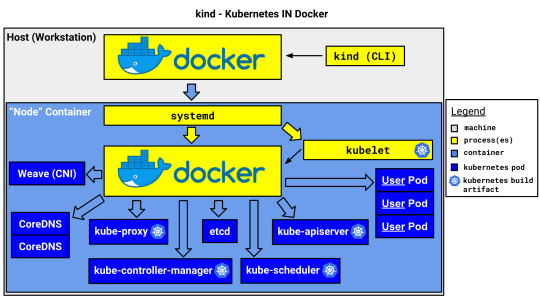
kind は開発・テスト用で、本番環境で使うものではありません。マルチノードクラスタに対応していますが、これは1つの物理or仮想マシン上で複数のVM(ノードコンテナ)をエミュレートできるという意味で、複数のマシンに跨ってクラスタを構成できるわけではありません。
MKE (Mirantis Kubernetes Engine)
MKE は Docker EE を買収した Mirantis の製品です。インストール手順はこちら
launchpad CLI から全ノードに対して ssh でログインして一斉にデプロイ可能で、Docker EE (MCR) のインストール、k8s のデプロイが実施されます。
RKE (Rancher Kubernetes Engine)
RKE は Rancher 社の製品です。
rke up コマンドで全ノードに対して ssh でログインして一斉にデプロイします。MKE と違い、Docker は事前にインストールしておかなければなりません。
なお、RKE の操作は CLI オンリーですが、Rancher Server を使用するとRKEクラスタ含む各種 Kubernetes クラスタの管理を GUI で行うことができます。
なお、上記は RKE1 の話で、RKE2 からは Docker には依存せず、containerd ベースになるようです。また Control plane は kubelet から static Pod として起動する形になるようです。
本題とずれますが Rancher/RKE は 100% OSS なのが良いです。他の商用製品は評価用はありますが本番で使うならライセンス購入が必要です。
c) 独自 OS タイプ
a), b) は OS は利用者が用意したものを使用しますが、このタイプは Kubernetes を動作させる OS 自体がディストリビューションに含まれているのが特徴です。
OCP (OpenShift Container Platform)
OCP はRedHat 社の製品 (OpenSource の OKD もあります)。OS には RedHat Core OS が使われています。
ベアメタルにインストールする場合は、物理マシンに Core OS をインストールし、この上に OpenShift をインストールすることになります。 ベアメタルにインストールする手順は ここにあります。インストール方法は以下の2通り。
IPI (Installer Provisioned Infrastructure)
インストーラが自動でインフラを構築する方法
各ノードをPXEブート(ネットワークブート)させ OS インストールする
UPI(User Provisioned Infrastructure)
ユーザが事前に用意してから構築する方法
ユーザが Core OS の CD-ROM を用意して各ノードをブートする
どちらの方法でも外部にプロビジョニング用のマシン、DHCPサーバ、DNSサーバなど用意しなければならないので準備が大変です。
d) VM タイプ
Kubernetes を稼働させるために専用の VM をデプロイするタイプです。
Minikube
Minikube は、Kubernetesが入った VM を立てるタイプです。Hyper-V や VirtualBox, VMware が使えます。また Docker も使えるので b) もできます。
なお、マルチノードクラスタは構成できません。シングルのみです。
Charmed Kubernetes
Charmed Kubernetes は Ubuntu で有名な Canonical の製品。
インストール方法は何通りかあるのですが、シングルノードにインストールするときは LXD を使って VM を立ててデプロイするという形になります。デプロイ用のツールは Juju というものを使います。
マルチノードデプロイする方法としては MAAS(Metal as a Service) を使うようです。これはローカルにクラウド環境を構築するようなものなので、VMware vSphere に似ている感じです(試してはいないですが)
VMware vSphere with Tanzu
VMware vSphere with Tanzu は VMware 社の製品。仮想化基盤の vSphere を用意し���その上に Kubernetes 用の VM を立てるという方式になります。VM 内で動作する OS は Photon OS なので、ある意味 c) にも近いとも言えます。
物理ノードにハイパーバイザの ESXi をインストールし、この上に VM を立てます。クラスタノード全体の管理には vCenter Server を使います。⇒ アーキテクチャ

すでに vSphere を導入しているところに立てる場合は良さげですが、オンプレ Kubernetes クラスタ1個だけのためにこれを使うのはさすがに(運用が)重いかな、という印象。
https://qiita-user-contents.imgix.net/https%3A%2F%2Fcdn.qiita.com%2Fassets%2Fpublic%2Farticle-ogp-background-1150d8b18a7c15795b701a55ae908f94.png?ixlib=rb-4.0.0&w=1200&mark64=aHR0cHM6Ly9xaWl0YS11c2VyLWNvbnRlbnRzLmltZ2l4Lm5ldC9-dGV4dD9peGxpYj1yYi00LjAuMCZ3PTg0MCZoPTM4MCZ0eHQ2ND00NEtxNDRPejQ0T1g0NE9zNDRPZjQ0SzVJRXQxWW1WeWJtVjBaWE1nNDRPSDQ0T1g0NE90NDRLazQ0T2k0NE9INDRPcjVxLVU2THlEJnR4dC1jb2xvcj0lMjMzMzMmdHh0LWZvbnQ9SGlyYWdpbm8lMjBTYW5zJTIwVzYmdHh0LXNpemU9NTQmdHh0LWNsaXA9ZWxsaXBzaXMmdHh0LWFsaWduPWNlbnRlciUyQ21pZGRsZSZzPWNkZDZkNmJlZjBiNTM5MmUwYzE3ZjUxYzljOWY4Yjk0&mark-align=center%2Cmiddle&blend64=aHR0cHM6Ly9xaWl0YS11c2VyLWNvbnRlbnRzLmltZ2l4Lm5ldC9-dGV4dD9peGxpYj1yYi00LjAuMCZ3PTg0MCZoPTUwMCZ0eHQ2ND1RSFJ0ZFhKaGEyRnRPVGsmdHh0LWNvbG9yPSUyMzMzMyZ0eHQtZm9udD1IaXJhZ2lubyUyMFNhbnMlMjBXNiZ0eHQtc2l6ZT00NSZ0eHQtYWxpZ249cmlnaHQlMkNib3R0b20mcz02NTE0ZTc3OTU1ODllZTg1NmQzZDI5MGU4ODc5NmU4NQ&blend-align=center%2Cmiddle&blend-mode=normal&s=fea070b2c5c5d84e1587a7132daaec13
1 note
·
View note
Text
Digital Transformation Helps Global SaaS Provider Achieve 300% Growth

Trintech is a rapidly growing financial software-as-a-service (SaaS) provider offering specialized accounting software that supports monthly, quarterly, and annual closings for large multinational companies. According to Matt Bertram, VP of Technology at Trintech, “our partnership with Dell Technologies, incorporating both Dell EMC PowerEdge and VMware Cloud Foundation, helped Trintech grow revenue by 300%, triple the number of SaaS customers supported on this infrastructure and increased operational efficiencies by more than 350%.” In addition, Matt reports that Dell EMC vSAN Ready Nodes running on Dell EMC PowerEdge servers increased IOPS by about 700%, while saving the company approximately 300% on SQL Server licensing costs.
The partnership began when Trintech set out to undertake an expansion and acquisition plan that would quintuple its employees and triple its customer base over a two-and-a-half-year period. To avoid growing pains, the IT team needed a reliable way to quickly roll out data centers on a global scale. Matt knew that digital transformation was the key to achieving the efficiency, flexibility, scalability and ease of deployment and management he would need to support the business though this expansion period and beyond.
Because of all these needs, Matt looked for a technology partner that could help him transform and modernize IT with a flexible foundation for growth. Matt selected Dell Technologies, saying “we knew that by continuing to grow, we would be able to leverage different Dell Technologies and VMware solutions that would provide us with generational leaps in terms of performance, availability, and overall resiliency within the global infrastructure.”
Trintech supports thousands of financial services customers worldwide, using Microsoft SQL Server for a range of customer facing SaaS applications. Trintech has invested in artificial intelligence (AI) and automation, integrating these with Microsoft SQL Server, enabling bots to perform routine functions for Trintech’s accounting and financial services customers.
By virtualizing SQL Server workloads on Dell EMC PowerEdge servers, Trintech was able to transition to VMware clusters, recognizing significant savings in compute utilization and storage along with significant performance gains and an enhanced ability to meet business continuity and disaster recovery (BCDR) objectives across a complex global infrastructure. This new infrastructure enabled the company to support 3x the number of SaaS customers, which drove a 3x increase in revenue.
Dell EMC OpenManage Enterprise was a critical tool for enabling rapid global expansion, with Matt sharing: “we saw a 350% increase in work done by infrastructure and operations teams, and we were able to deploy multiple data centers in new geographic regions within hours to weeks instead of multiple months.”
Matt and his team plan to build on their initial success by continuing to upgrade their VMware Cloud Foundation environments, including deploying VMware vSphere 7 and leveraging VMware Tanzu for Linux and Windows containers. This will enable Trintech to automate DevOps with a future-focused Kubernetes platform for cloud-native apps. Matt anticipates that “we will be able to decrease the time to deploy new versions of our product from hours to seconds.”
0 notes
Text
vSphere 7 with Tanzu Updates
Updating vSphere 7 with #Tanzu Clusters #Kubernetes
At some point, you’ll be faced with an upgrade request. New Kubernetes features, new security patches, or just to maintain your support. A vSphere 7 with Tanzu deployment has several components that may need to be updated and most of which can be updated independently of one another. In this post we’ll walk through an update to vSphere, then update the Supervisor namespace, and then finally the…

View On WordPress
1 note
·
View note
Text
VCP-AM 2021 2V0-71.21 Questions and Answers
The best way to prepare for your 2V0-71.21 Professional VMware Application Modernization exam is to download the latest VCP-AM 2021 2V0-71.21 Questions and Answers from PassQuestion. After your preparation for Professional VMware 2V0-71.21 exam by using PassQuestion VCP-AM 2021 2V0-71.21 Questions and Answers, you will be ready to pass the VMware 2V0-71.21 exam confidently which will make 100% guaranteed your success in the first attempt with good grades.PassQuestion VCP-AM 2021 2V0-71.21 Questions and Answers are the best preparation way that confirms your success in the first attempt.
Professional VMware Application Modernization 2V0-71.21 Exam Description
The Associate VMware Application Modernization (2V0-71.21) exam, which leads to VMware Certified Professional –Application Modernization 2021 certification is a 55-item exam, with a passing score of 300 using a scaled method.Candidates are given 130 minutes to complete the exam, which includes adequate time to complete the exam for nonnative English speakers. 2V0-71.21 exam tests a candidate's expertise with VMware Tanzu Standard Edition including vSphere with Tanzu, Tanzu Kubernetes Grid, and Tanzu Mission Control. The exam also tests fundamental cloud native skills including containerization, Kubernetes, and application modernization.
2V0-71.21 Exam Information
Exam Number: 2V0-71.21 Exam Language: English Associated Certification: VCP-AM 2021 Duration: 130 minutes Number of Questions: 55 Questions Passing Score: 300 Format: Single and Multiple Choice, Proctored
2V0-71.21 Exam Topics
Section 1 – Architecture and Technologies Section 2 – Products and Solutions Section 3 – Planning and Designing Section 4 – Installing, Configuring, and Setup Section 5 – Performance-tuning, Optimization, and Upgrades Section 6 – Troubleshooting and Repairing Section 7 – Administrative and Operational Tasks
View Online Professional VMware Application Modernization 2V0-71.21 Free Questions
Which prerequisite must be configured before starting the Tanzu workload management enablement wizard? A.Content library B.Tanzu Mission Control C.Storage policy D.Tanzu Build Service Answer: A
Why is the port 6443 required in the boostrap machine to deploy Tanzu Kubernetes Grid on vSphere environment? A.Kubernetes IP is exposed B.Kubernetes API is exposed C.Kubernetes TLS is exposed D.Kubernetes VPN is exposed Answer: B
Which component can intercept requests to the Kubernetes API? A.Network Policy B.RBAC Authorization C.Pod Security Policies D.Admission Controllers Answer: D
Which option provides a configuration blueprint to deploy Tanzu Kubernetes clusters? A.Tanzu Kubernetes Cluster Spec B.Tanzu Kubernetes Grid Installer C.Tanzu ClusterAPI Provider D.Tanzu Kubernetes Cluster Plan Answer: D
What is the command to find out the available node base operating system images? A.kubectl get nodes B.kubectl cluster-info C.kubectl get virtualmachineclasses D.kubectl get virtualmachineimages Answer: A
0 notes
Text
Vmware Vsphere Client For Mac Os

For macOS virtual machines you install or upgrade VMware Tools using an installer assistant.
If you use VMware Fusion or ESXi on a computer with an Apple label, you can create Mac OS X Server (10.5 or later) virtual machines and install VMware Tools.
VMware delivers virtualization benefits via virtual machine, virtual server, and virtual pc solutions. VClient is a native Mac application to manage VMware vSphere and ESX(i) servers It will support vSphere 7.0 and Project Pacific! Get rid of web console, try out native client NOW! For Mac OS, download VMware Tanzu Kubernetes Grid CLI 1.1.3 Mac. In the vSphere Client, right-click an object in the vCenter Server inventory, select Deploy OVF template. Select Local file, click the button to upload files, and navigate to a downloaded OVA file on your local machine.
Vmware Vsphere Client For Macos
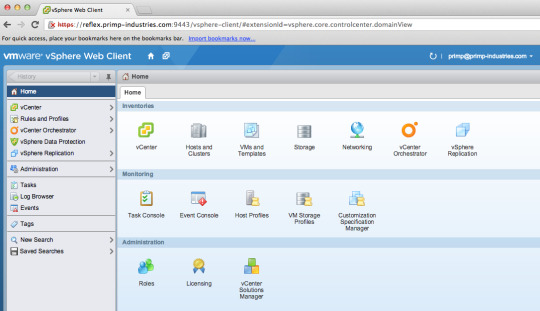
Power on the virtual machine.
Verify that the guest operating system is running.
Procedure
Vmware Vsphere Client For Mac Os 10.8
Select the menu command to mount and open the VMware Tools virtual disc on the guest operating system.
VMware ProductMenu CommandvSphere ClientInventory > Virtual Machine > Guest > Install/Upgrade VMware Tools and select Interactive Tools Installation or Interactive Tools UpgradevSphere Web ClientRight-click the virtual machine in the vCenter inventory and select All vCenter Actions > Guest OS > Install/Upgrade VMware ToolsFusionVirtual Machine > Install (or Upgrade) VMware Tools
Open Install VMware Tools on the VMware Tools virtual disc, follow the prompts in the installer assistant, and click OK.
The virtual machine restarts to have VMware Tools take effect.

0 notes
Text
Tanzu Kubernetes Grid 1.2 installation fails at the create management cluster stage
Tanzu Kubernetes Grid 1.2 installation fails at the create management cluster stage
While working on a TKG 1.2.0 on vSphere, we faced this issue issue due to which the TKG installation was failing. Symptoms: Deploying a Tanzu Kubernetes Grid (TKG)1.2 management cluster on vSphere fails at stage 5 of 8The management cluster creation does not initiate and no virtual machines are created You see messages noting connectivity issue with vSphere in the capv-controller-manager pod…
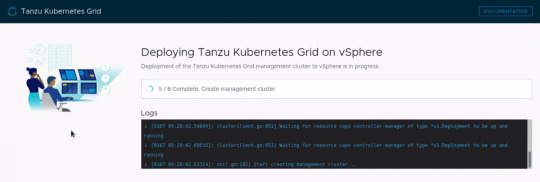
View On WordPress
0 notes